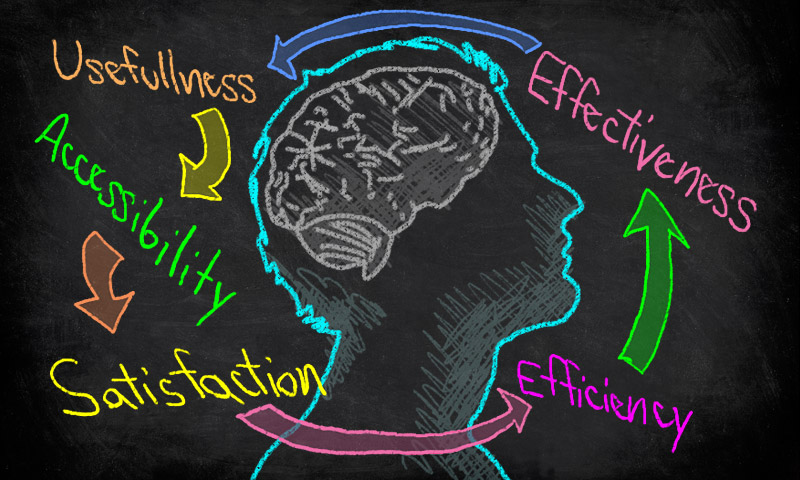What exactly does a UX designer do?
Published

UX design: What it is, why it's important, and how to get started
UX design is the process of developing digital products that are easy to use, visually appealing, and pleasant to interact with. Whether you're designing a website, app, or other digital product, good UX design is essential to creating a positive user experience and ensuring the success of your project. In this article, we'll take a closer look at what UX designers do, how much they make, how to get into the field, and more.
Introduction to UX design
UX design is a process that focuses on designing digital products that are user-friendly, visually appealing, and pleasant to use. A good UX designer takes into account the needs, preferences and behavior of the target audience to design a product that meets their needs and expectations.
The importance of UX design lies in its ability to create a positive user experience. In today's competitive digital landscape, users have many options when it comes to choosing products and services. A great user experience can help you stand out from the competition, strengthen customer loyalty and increase sales.
What a UX Designer Does

Those : resolutesoftware.com
UX designers are responsible for the entire user experience, from researching user needs and behavior to designing and testing the final product. The most important tasks of a UX designer include:
- Conducting user research : UX designers use a variety of methods to gain insights into user needs and behavior, including interviews, surveys, and observations.
- Creating personas and user journeys : Based on insights from user research, UX designers create user personas and user journeys to guide the design process.
- Wireframing und Prototyping : UX designers create wireframes and prototypes to test and refine their design ideas before designing the final product.
- Usability testing and obtaining feedback: UX designers conduct usability tests and collect feedback from users to identify opportunities for improvement.
- Continuous improvement and iteration : UX designers continually evaluate and improve the user experience based on user feedback and data.
Training paths to become a UX designer
There are different training paths you can take to become a UX designer. Some people choose to learn their skills self-taught through online courses, books, and other resources. Others may enroll in boot camps or pursue a degree in a related field such as graphic design, human-computer interaction, or psychology.
Self-study
One of the most common ways to learn UX design is through self-study. With the extensive resources available on the Internet, it has become easier for aspiring designers to teach themselves the necessary skills. There are a plethora of online courses, tutorials, and blogs covering topics such as wireframing, prototyping, usability testing, and information architecture.
The advantage of self-study is the flexibility it offers. Individuals can learn at their own pace and tailor their learning to their specific interests. However, self-study requires a high level of self-discipline and motivation in order to stay on track.
Bootcamps
Another option for people interested in UX design is to attend a bootcamp. Bootcamps are intensive, short-term programs designed to equip students with the skills needed to quickly enter the industry. Bootcamps often cover a range of topics, such as design theory, user research, prototyping and programming.
Bootcamps can be expensive, but they offer a structured learning experience and a community of fellow students and mentors. Additionally, many bootcamps offer job placement assistance to help graduates find their first UX design job.
University degrees
A third option for people interested in UX design is to obtain a university degree in a related field. Many universities offer undergraduate and postgraduate courses in areas such as graphic design, human-computer interaction and psychology. These degrees provide more comprehensive training and can provide more opportunities for specialization.
However, university degrees can be time-consuming and expensive. Additionally, they may not provide the same level of practical experience and practical skills as bootcamps or self-study programs.
Regardless of the educational path you choose, it is important to develop a solid portfolio of work that showcases your design skills and thought processes.
Responsibilities of a UX designer
The scope of a UX designer can vary depending on the company, product, and project they are working on. However, there are some common tasks that most UX designers have:
Conducting user research
One of the main tasks of a UX designer is to conduct user research to understand the needs, goals and problems of the target audience. User research methods include surveys, interviews, usability testing and ethnographic research.
Creating personas and user flows
Based on the findings from user research, UX designers create personas, i.e. fictional representations of the target audience. Personas help designers better understand their users' needs and behaviors.
UX designers also create user flows, which are diagrams that show how users navigate through a product. Using user flows, designers can identify areas of the product that may need improvement and ensure a seamless user experience.
Designing wireframes and prototypes
Once user research and user flows are established, UX designers move on to creating wireframes and prototypes. Wireframes are low-fidelity, grayscale representations of the product, usually created using wireframing tools such as Sketch, Figma, or Adobe XD. They help UX designers visualize the layout and hierarchy of the product interface without getting bogged down in details like color and typography.
Prototypes, on the other hand, are realistic representations of the product that simulate user interactions. They can be created with tools like InVision, Proto.io or Axure. Prototypes allow UX designers to test their design concepts with users and stakeholders and get feedback before moving on to the final design.
Wireframes and prototypes are essential tools in the UX design process because they help ensure the final product meets users' needs and is easy to use. By testing and refining their design concepts through wireframing and prototyping, UX designers can create a product that is both aesthetically pleasing and functional.
Career Paths in UX Design
A career in UX design can be very rewarding, both in terms of job satisfaction and financial reward. In this section, we will discuss some possible career paths for UX designers.
Junior UX-Designer
Junior UX designers are young professionals who have recently graduated or have just started their career in this field. You will work under the supervision of senior designers and will be responsible for assisting with design research, creating wireframes, and designing low-fidelity prototypes. The salary of a Junior UX Designer in Germany, Switzerland and Austria is between 30,000 and 45,000 euros per year, depending on experience and location. (Source: Glassdoor)
Mid-level UX designer
Mid-level UX designers have 3-5 years of experience and are responsible for leading projects, conducting research, creating high-fidelity prototypes, and collaborating with other designers and stakeholders. The salary of a mid-level UX designer in Germany, Switzerland and Austria is between 50,000 and 70,000 euros per year, depending on experience and location.
Senior UX-Designer
Senior UX Designers have 5+ years of experience and are responsible for leading design teams, conducting design research, and designing complex systems. They are also responsible for mentoring junior and mid-level designers. The salary of a senior UX designer in Germany, Switzerland and Austria is between 70,000 and 100,000 euros per year, depending on experience and location.
UX-Manager
UX managers are responsible for managing and leading a team of UX designers. They set design strategy, manage budgets, and ensure design projects are completed on time and within budget. The salary of a UX manager in Germany, Switzerland and Austria is between €90,000 and €130,000 per year, depending on experience and location.
Chief Designer: A chief design officer is a senior executive responsible for setting a company's design vision and strategy. You will be responsible for leading the design team, setting design standards and ensuring that the design is consistent with the company's overall goals. The salary of a Chief Design Officer in Germany, Switzerland and Austria is between 150,000 and 250,000 euros per year, depending on experience and location.
You can find this and other salary information given in the article at Glassdoor .
How much does a UX designer make? UX designer wages in Germany, Switzerland and Austria

Those : coursera.org
One of the most attractive aspects of being a UX designer is the earning potential. According to Glassdoor, the average salary of a junior UX designer in Germany is 44,000 euros per year, while a mid-level UX designer earns an average of 55,000 euros per year. Senior UX designers can expect an annual salary of around 75,000 euros, while UX managers earn an average of 90,000 euros per year. Chief Design Officers, who lead the entire design team, can earn up to 140,000 euros a year.
In Switzerland, the average annual salary of a junior UX designer is 76,000 CHF, while mid-level UX designers can expect to earn around 98,000 CHF per year. Senior UX designers in Switzerland earn an average of 127,000 CHF per year, while UX managers earn an average of 140,000 CHF per year. Chief Design Officers can expect an annual salary of up to CHF 200,000.
In Austria, the average annual salary of a junior UX designer is €37,000, while mid-level UX designers earn an average of €45,000 per year. Senior UX designers can expect an annual salary of around 65,000 euros, while UX managers earn an average of 76,000 euros per year. Chief Design Officers can earn up to 120,000 euros a year.
It is important to note that these salaries are averages and may vary depending on location, company, and years of experience.
Demand for UX designers in Germany, Switzerland and Austria
With the increasing importance of user experience, the demand for qualified UX designers is also increasing. According to a study by the Federal Association of the Digital Economy (BVDW), there is currently a shortage of UX designers in Germany. Around 75% of companies have problems finding qualified candidates. This trend is expected to continue in the coming years as the Demand for UX designers is expected to increase by 13% .
Demand for UX designers is also high in Switzerland, especially in the financial and technology sectors. The Swiss UX Design Association reports that there are currently more job vacancies than qualified candidates to fill them.
The need for UX designers is also increasing in Austria, especially in the areas of e-commerce and software development. According to the Austrian Economic Chamber, companies are increasingly recognizing the importance of UX design, which is leading to increasing demand for qualified specialists in this area.
Benefits for UX Designers
Aside from the potential high salaries, there are many other benefits to pursuing a career in UX design. On the one hand, it is a very creative area that allows a lot of autonomy and self-realization. UX designers also have the opportunity to work on a variety of projects, from mobile applications to websites to physical products.
In addition, many companies have recognized the importance of work-life balance and are offering flexible work arrangements, such as remote working options and flexible working hours. UX designers also have the opportunity to work for companies that have a strong culture and values that align with their own.
Possible challenges and disadvantages of UX design
While working in UX design has many benefits, there are also some potential challenges and drawbacks to consider. For one thing, the field is constantly evolving, and it can be time-consuming to keep up with the latest design trends and technologies.
Additionally, working in UX design can be demanding, especially when it comes to meeting tight deadlines or dealing with difficult stakeholders. It is important that UX designers have good communication and project management skills to ensure projects are completed on time and within budget.
What separates the best UX designers from the rest

Those : impatientdesigner.com
The best UX designers stand out from the crowd for several reasons. First, they have a deep understanding of user needs and behavior and are able to design intuitive and engaging user experiences. They also have a strong understanding of design principles, including typography, color theory and layout.
Another important trait of top UX designers is their ability to communicate effectively with team members, stakeholders, and customers. They are able to clearly articulate their design decisions and explain how their designs meet user needs and business goals. Additionally, top UX designers often have knowledge of research methodologies, including user testing and analysis, which allows them to create designs based on user data and feedback.
Conclusion
In summary, UX design is an important component of modern product development, ensuring that digital products are user-friendly, effective and aesthetically pleasing. UX designers must have a deep understanding of user needs, behaviors, and motivations and have the technical skills necessary to create wireframes, prototypes, and other design elements.
The demand for UX designers is increasing rapidly in Germany, Switzerland and Austria, offering opportunities in a variety of industries and sectors. The average salary for UX designers in these countries varies depending on experience, seniority and location, but is generally quite competitive compared to other professions.
There are various paths to becoming a UX designer, including self-study, bootcamps, and university programs. Regardless of which path you choose, a willingness to continually learn and develop is essential to keeping up with the latest trends and techniques in UX design.
While working as a UX designer has many advantages and conveniences, such as the opportunity to work on exciting projects and collaborate with talented colleagues, there are also challenges and disadvantages, such as: B. the need to balance user needs with company goals and deadlines.
Ultimately, what sets the best UX designers apart is their ability to empathize with users, collaborate effectively with stakeholders, and combine technical skills with creativity and innovation.
If you're interested in a career in UX design, there's never been a better time to get started. With your commitment to ongoing learning and development and your passion for creating user-centered designs, you can build a rewarding and fulfilling career in this exciting and fast-growing field.








